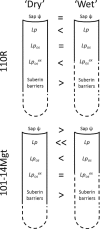Differential responses of grapevine rootstocks to water stress are associated with adjustments in fine root hydraulic physiology and suberization
- PMID: 26160580
- PMCID: PMC4615816
- DOI: 10.1093/jxb/erv324
Differential responses of grapevine rootstocks to water stress are associated with adjustments in fine root hydraulic physiology and suberization
Abstract
Water deficits are known to alter fine root structure and function, but little is known about how these responses contribute to differences in drought resistance across grapevine rootstocks. The ways in which water deficit affects root anatomical and physiological characteristics were studied in two grapevine rootstocks considered as low-medium (101-14Mgt) and highly (110R) drought resistant. Rootstocks were grown under prolonged and repeated drying cycles or frequent watering ('dry' and 'wet' treatments, respectively), and the following parameters were evaluated: root osmotic and hydrostatic hydraulic conductivity (Lp os and Lp hyd, respectively), suberization, steady-state root pressure (P rs), sap exudation rates, sap osmotic potential, and exosmotic relaxation curves. For both rootstocks, the 'dry' treatment reduced fine root Lp, elicited earlier root suberization and higher sap osmotic potential, and generated greater P rs after rewatering, but the rootstocks responded differently under these conditions. Lp os, Lp hyd, and sap exudation rates were significantly higher in 110R than in 101-14Mgt, regardless of moisture treatment. Under 'dry' conditions, 110R maintained a similar Lp os and decreased the Lp hyd by 36% compared with 'wet' conditions, while both parameters were decreased by at least 50% for 101-14Mgt under 'dry' conditions. Interestingly, build-up of P rs in 110R was 34% lower on average than in 101-14Mgt, suggesting differences in the development of suberized apoplastic barriers between the rootstocks as visualized by analysis of suberization from fluorescence microscopy. Consistent with this pattern, 110R exhibited the greatest exosmotic Lp os (i.e. Lp os of water flowing from roots to the soil) as determined from relaxation curves under wet conditions, where backflow may have limited its capacity to generate positive xylem pressure. The traits studied here can be used in combination to provide new insights needed for screening drought resistance across grapevine rootstocks.
Keywords: Drought resistance; Lp; Vitis.; fine root conductivity; root hydraulics; traits.
Published by Oxford University Press on behalf of the Society for Experimental Biology.
Figures








Similar articles
-
Differences in grapevine rootstock sensitivity and recovery from drought are linked to fine root cortical lacunae and root tip function.New Phytol. 2021 Jan;229(1):272-283. doi: 10.1111/nph.16542. Epub 2020 Apr 18. New Phytol. 2021. PMID: 32171020
-
The relationship between root hydraulics and scion vigour across Vitis rootstocks: what role do root aquaporins play?J Exp Bot. 2012 Nov;63(18):6445-55. doi: 10.1093/jxb/ers312. Epub 2012 Nov 7. J Exp Bot. 2012. PMID: 23136166 Free PMC article.
-
Root pressure-volume curve traits capture rootstock drought tolerance.Ann Bot. 2022 Mar 23;129(4):389-402. doi: 10.1093/aob/mcab132. Ann Bot. 2022. PMID: 34668965 Free PMC article.
-
Reassessing Drought Tolerance in Citrus Tetraploid Rootstocks: Myth or Reality?Physiol Plant. 2025 Mar-Apr;177(2):e70199. doi: 10.1111/ppl.70199. Physiol Plant. 2025. PMID: 40171952 Free PMC article. Review.
-
Soil Rather Than Xylem Vulnerability Controls Stomatal Response to Drought.Trends Plant Sci. 2020 Sep;25(9):868-880. doi: 10.1016/j.tplants.2020.04.003. Epub 2020 May 3. Trends Plant Sci. 2020. PMID: 32376085 Review.
Cited by
-
Environmental Factors Influence Plant Vascular System and Water Regulation.Plants (Basel). 2019 Mar 15;8(3):65. doi: 10.3390/plants8030065. Plants (Basel). 2019. PMID: 30875945 Free PMC article. Review.
-
Modeling vegetative vigour in grapevine: unraveling underlying mechanisms.Heliyon. 2020 Dec 22;6(12):e05708. doi: 10.1016/j.heliyon.2020.e05708. eCollection 2020 Dec. Heliyon. 2020. PMID: 33385078 Free PMC article.
-
Physiology of salt tolerance introgressions from Solanum galapagense in the domesticated tomato.Front Plant Sci. 2025 May 15;16:1568851. doi: 10.3389/fpls.2025.1568851. eCollection 2025. Front Plant Sci. 2025. PMID: 40443441 Free PMC article.
-
Convergent evolution of gene regulatory networks underlying plant adaptations to dry environments.Plant Cell Environ. 2021 Oct;44(10):3211-3222. doi: 10.1111/pce.14143. Epub 2021 Jul 12. Plant Cell Environ. 2021. PMID: 34196969 Free PMC article. Review.
-
Physiological, biochemical and elemental responses of grafted grapevines under drought stress: insights into tolerance mechanisms.BMC Plant Biol. 2025 Mar 26;25(1):385. doi: 10.1186/s12870-025-06374-4. BMC Plant Biol. 2025. PMID: 40133817 Free PMC article.
References
-
- Aroca R, Porcel R, Ruiz-Lozano JM. 2012. Regulation of root water uptake under abiotic stress conditions. Journal of Experimental Botany 63, 43–57. - PubMed
-
- Barrios-Masias FH, Jackson LE. 2014. California processing tomatoes: morphological, physiological and phenological traits associated with crop improvement during the last 80 years. European Journal of Agronomy 53, 45–55.
Publication types
MeSH terms
Substances
LinkOut - more resources
Full Text Sources
Other Literature Sources
Molecular Biology Databases
Miscellaneous

